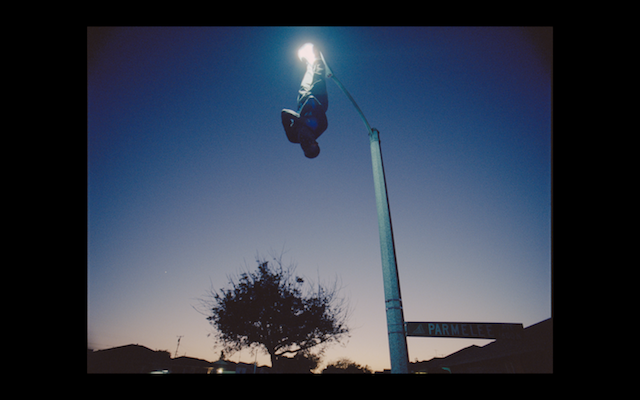The watchful camera brings you in close – closer to what it films, probably, than you’ve ever been before. You find yourself in Compton, California, in nondescript vacant lots; in the chapel of a mortuary; on the backseat of a car. Everywhere you go, you hear the merged sounds of hip-hop, shooting, prayer and laughter. In the pulsating flow of images, bare-chested African Americans show off muscular bodies in the burning sun; a black man, seemingly lynched, dangles head-down from a lamppost at night. Amid the overwhelming sound, in this atmosphere of menace and brooding eroticism, you can’t stop watching, nor asking yourself what the hell is going on.
m.A.A.d (2014), outlined above, is the first work you see upon entering New Suns by Kahlil Joseph, the Los Angeles-based artist known for directing music videos for Beyoncé and Kendrick Lamar. Its footage, projected onto two giant screens arranged in a V shape, combines documentary, surveillance-camera imagery, staged scenes and nocturnal aerial views. Some of the material was produced as a backdrop for a 2013 Lamar concert tour: it was Joseph’s late brother, Noah Davis, an artist himself, who suggested turning the footage into a video installation. m.A.A.d. marked the start of Joseph’s rapid rise to fame, with shows in MOCA, Los Angeles, the New Museum in New York and Tate Modern in London inside three years.
‘There’s nothing new under the sun,’ wrote the Afro-futurist science-fiction author Octavia Butler, ‘but there are new suns’ – a line quoted in the exhibition brochure as having strongly affected Joseph. Wandering through the show, this new sun appears to be a dark star. Take Wildcat (Aunt Janet) (2016), a three-channel video with a soundtrack by Flying Lotus projected onto transparent screens hung in a triangle. Dawn blends with twilight in a silver-greyish continuum to create an eerie new sunlight in which you can vaguely discern the gigantic head of a horse, a silhouette of a Southern belle and two men on a motorbike. The footage was shot at the annual African-American rodeo in Oklahoma; the floor of the installation is covered with dirt from the bull rider’s ring.
Other video installations, featuring music and musical instruments, echo with the affective power of jazz, hip-hop and reggae. Wizard of the Upper Amazon (2016) reconstructs a room in the backstage area of a gig, a scenery that is also the subject of two black-and-white films beamed onto the walls. In them, dreadlocked Rastafarians in sunglasses sit on folding chairs lined up along the wall, smoking, chatting, waiting. You sit on the same chairs, at the same table that holds, and held, a cassette player and rolling paper. Being here, around the old tech, throws you decades back in time. On the wall hangs a painting by American artist Henry Taylor – whose memories of meeting Bob Marley during the 1970s inform the making of the film – suggesting cross-disciplinary connections in the way black identity is expressed.
In this way, crossing between film and physical space, Joseph’s hypnotising visual riffs are edited into chains of suggestive impressions, confusing time and place, blurring the narrative. The Philosopher (2017), consists of ten variously sized flatscreens loosely distributed across pitch-black walls. They show looping images of majestic tropical trees, a man waiting on a pier and a young boy swimming in the ocean, all filmed near Freetown, Sierra Leone. It’s more rewarding to submerge yourself in this flickering sea of disconnected events, which deliberately avoids a legible storyline in favour of reverie, than to try to make sense of it.
Alongside the video installations – of which there are seven, each exhibited in a separate room – here and there you see works by the artist’s family and friends. These include a wall piece of fluorescent lights by Davis, glowing like a modern-day halo, and spiritual paintings by his mother, widowed by the untimely death of Joseph’s father. Such personal additions reinforce an overall atmosphere of existential loss and grief, intimate and alienating at the same time. Although comparisons with other artists occasionally spring to mind (Doug Aitken, Steve McQueen, Apichatpong Weerasethakul), Joseph has developed his own style of expanded videomaking, mixing private testimonies on black culture with pensive meditation on time passing irreversibly by. The sunshine here is bright, but the shadows are long.
Kahlil Joseph: NEW SUNS at Bonnefantenmuseum, Maastricht, 1 December – 25 March
From the May 2018 issue of ArtReview
